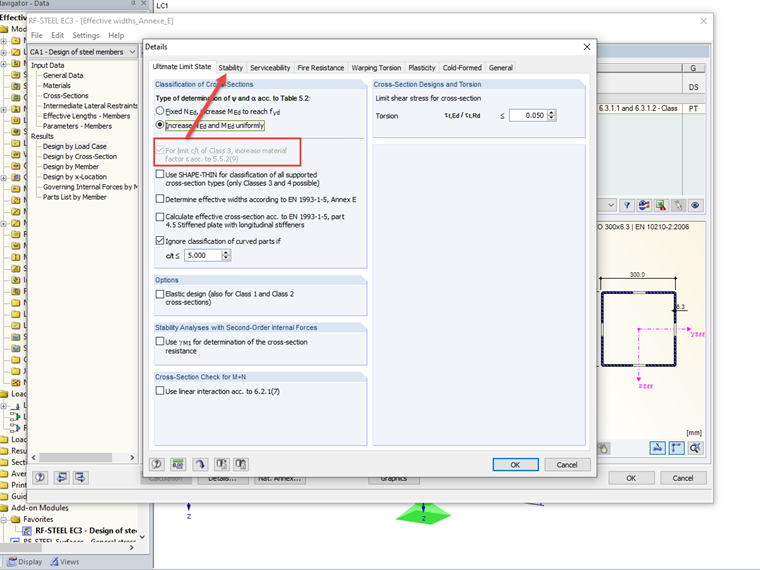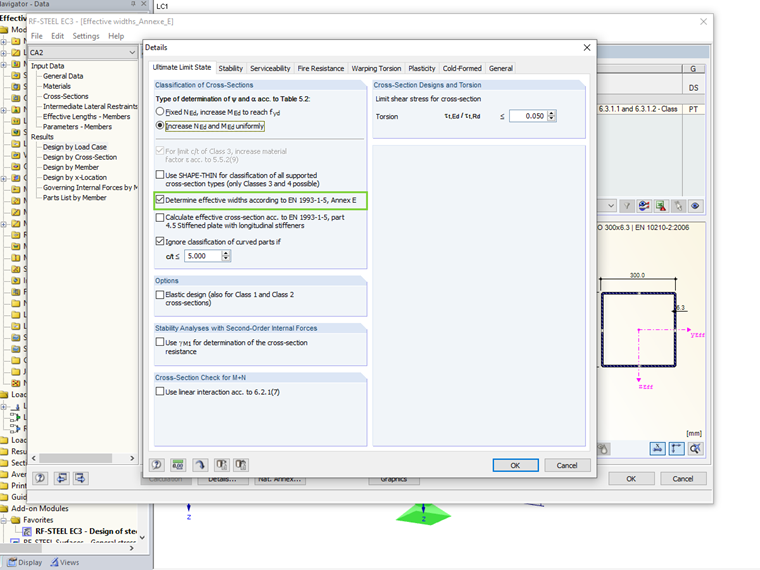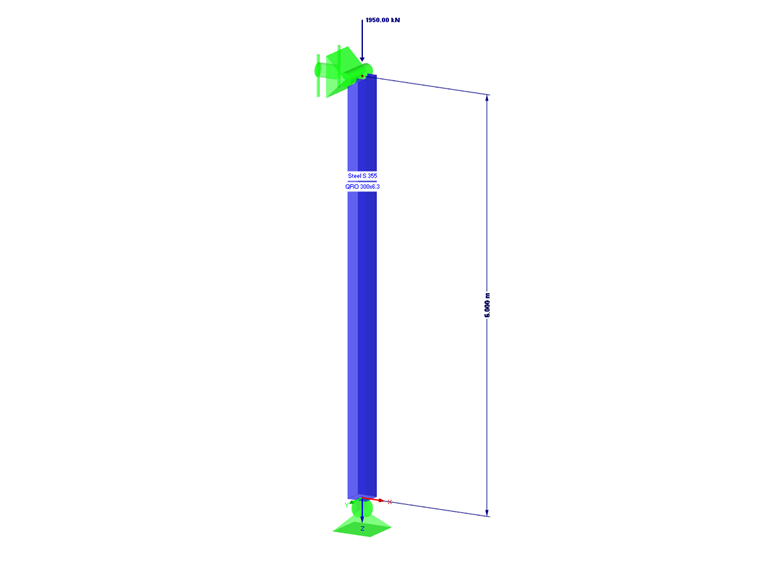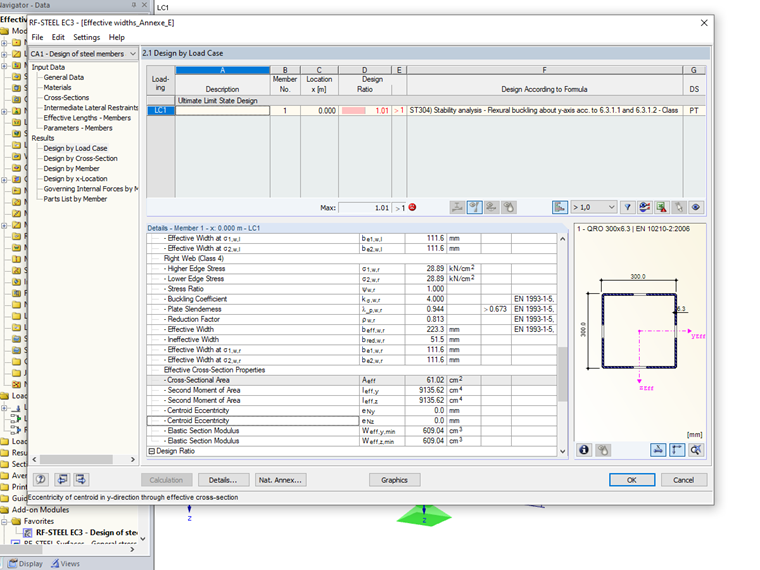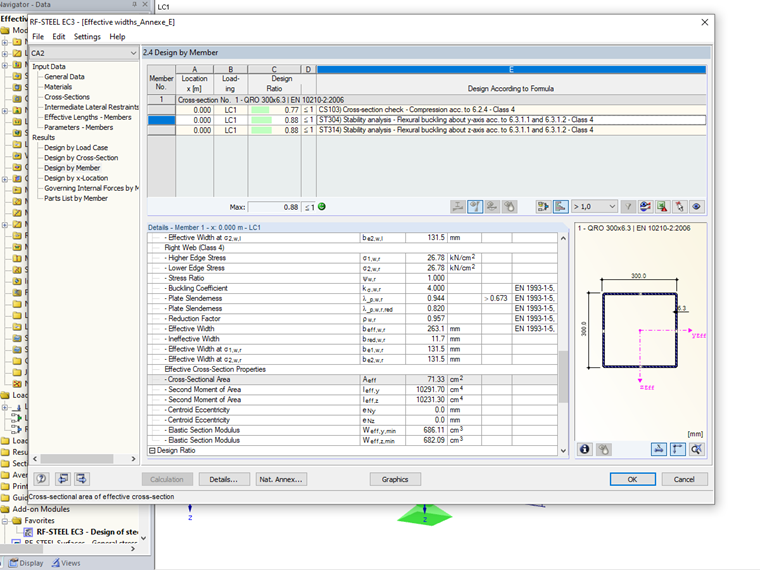Usually, this classification is performed on the assumption that the stress in the cross-section part reaches the yield strength. However, in other standards (for example, the previous standard DIN 18800), the b/t limits were determined on the basis of the actual stresses in the cross-section. According to Eurocode 3, this may result in more unfavorable limits for stresses below the yield strength.
Adjustment of the material coefficient for cross-section designs
According to EN 1993-1-1, it is possible to adjust to the actual compressive stress in the cross-section by means of the increased material coefficient ε according to Section 5.5.2 (9). However, this blanket adjustment is not provided for stability designs according to Section 6.3. In RF-/STEEL EC3, this option is, therefore, only available if the stability analyses are deactivated.
Reduced slenderness is also possible for stability analyses
According to EN 1993-1-5, 4.4 (4), the slenderness ratio can be iteratively improved on the basis of the applied compressive stress. The compressive stress is to be determined for stability analyses using global imperfections and according to the second-order theory.
|
λp,red |
Reduzierter Beulschlankheitsgrad |
|
λp |
Beulschlankheitsgrad |
|
σcom,Ed |
Bemessungswert der Druckspannung |
|
fy |
Streckgrenze |
|
γM0 |
Teilsicherheitsbeiwert für Querschnittsbeanspruchbarkeit |
Determination of the effective widths according to Annex E
According to Annex E of EN 1993-1-5, the adjusted formulas may then be used to determine the reduction factor for plate buckling.
|
ρ |
Angepasster Abminderungsfaktor |
|
λp,red |
Reduzierter Beulschlankheitsgrad |
|
λp |
Beulschlankheitsgrad |
|
ψ |
Spannungsverhältnis |
The use of the reduced slenderness ratio, as well as the calculation of the adjusted reduction factor according to Annex E, can be activated in the detail settings of RF-/STEEL EC 3.
Example
In the following example, a 6-meter-long pendulum column (QRO 300x6.3, hot-finished) made of S355 is designed for an acting design compressive force of 1950 kN.
The effective cross-section properties are determined taking into account the actual compressive stress+ according to Annex E. In the case of the present hinged column, the global imperfections as well as the effects according to the second-order theory are without influence, so the determination of internal forces according to the first-order theory without imperfections is sufficient.
For comparison, the design without using Annex E is tried first. Since the stability analysis should also be performed, it is impossible to increase the material factor epsilon to consider the actual compressive stresses when determining the cross-section class.
The cross-section is classified in cross-section class 4 on the basis of the c/t ratios. According to EN 1993-1-5, 4.4, the cross-section properties result from the assumption that the yield strength is reached.
The design is not fulfilled with these cross-section properties.
After activating Annex E in the detail settings, the actual size of the compressive stresses is taken into account. The reduced slenderness ratio is determined iteratively and the more favorable effective cross-section properties according to EN 1993-1-5, Annex E can be used for the design.
The design using the cross-section values according to Annex E is fulfilled.
Conclusion
The calculation of the effective cross-section properties according to EN 1993-1-5, 4.4 is initially based on the worst case, where the existing compressive stress in the cross-section parts is equal to the yield strength. However, if the actually existing compressive stresses are significantly lower, the actual risk of buckling is reduced and a larger effective cross-section can be considered. The determination of the cross-section properties with the effective slenderness ratio according to Annex E allows for a significantly more economical design in these cases.
Please note that the actual compressive stresses must be determined according to the second-order theory using global imperfections.
